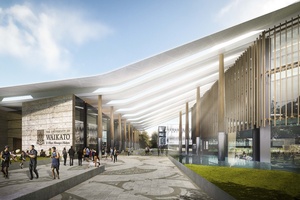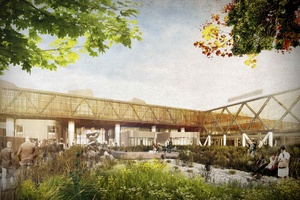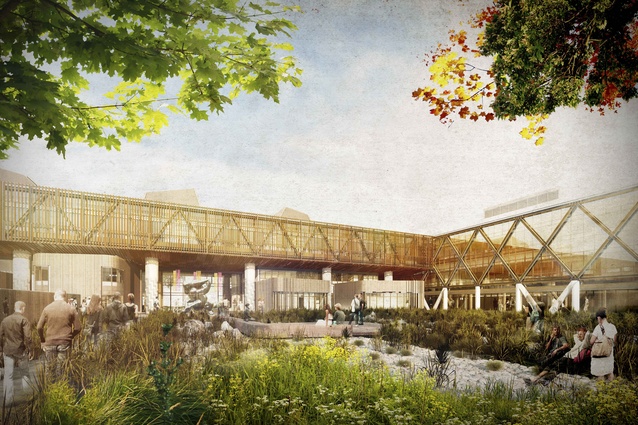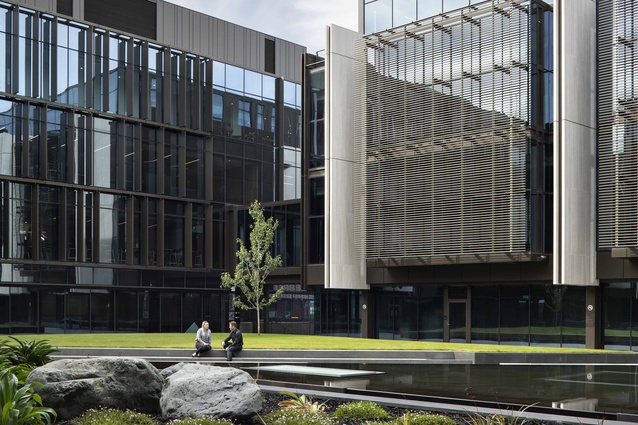Diversity talks: Ngata Tapsell
After working across Sydney, Dubai and Singapore, Ngata Tapsell returned to his native New Zealand to join Warren and Mahoney’s Auckland studio. Along with working on large-scale commercial, retail, hospitality, residential and civic projects, he also heads up The Warren and Mahoney Advanced Māori Design Unit, Te Matakīrea. He talks to Justine Harvey about returning home and being an advocate for indigenous architecture.
Justine Harvey (JH): You’ve had quite an interesting career so far. Coming back to New Zealand after working overseas and heading up the Māori division at Warren and Mahoney is a big thing to do.
Ngata Tapsell (NT): When I left the country, which was 2005, I felt that New Zealand wasn’t quite ready for the types of projects and the types of work I wanted to do at the time. The projects that Māori were commissioning themselves were quite small, and they were few and far between.
The key difference I see in the time since I’ve been away is a huge change in attitudes towards involving Māori in the building process, and Māori are probably better resourced than at any point since 1840. They’re actually commissioning their own projects, and that’s great. To some degree, most of the main architectural practices probably see that as a key commercial opportunity, but at the same time, I think there’s a genuine attitude towards doing those projects well and authentically.
Before I returned to New Zealand, I probably spent the better part of nine months to a year planning my move back, and I was quite careful about where I wanted to come and what I wanted to do.
JH: And you began working with Warren and Mahoney.
NT: Yes. They painted a very progressive, receptive workplace, which I was keen to be a part of. Once they got to know my own views on where I saw the practice taking our engagement with Māori and how we wanted to do that, it was quite a natural fit.

JH: You worked on some quite large projects while you were overseas, and Warren and Mahoney also does large commercial projects here. Was that a draw as well?
NT: Yes, that was appealing. One of the things I did during the first six months I was at Warren and Mahoney was to set in place a charter for how I saw the practice engaging in Te Ao Māori and the stance we would take: both to get work, to position ourselves as slightly different to what others in the market were offering and to do so in a way that was completely compatible in the context of two world views: one being Māori and the other being Warren and Mahoney’s substantial modernist history in Christchurch. To me, I saw that as a challenge, but not an insurmountable one.
JH: You’re honouring a legacy of architecture, particularly in a practice that’s had a strong style. But, it’s also a practice that’s doing new things. We’re living in a different world now, with different views: one that is bringing in Te Ao Māori and that is affecting New Zealand architecture. Do you have any thoughts about where we go from here? How do we move forward?
NT: Interestingly, I was at an indigenous architects’ symposium in Melbourne a few months ago. It was clear that we as New Zealanders are kind of leading the way in many respects. We’re looked up to by many other indigenous communities in the world. It’s a source of pride but also a challenge to not drop the ball. The other thing that was very apparent to me was that the scale of the work being done by those indigenous communities around the world is completely different to what we’re finding ourselves involved in here.
In terms of Warren and Mahoney and the direction we’re taking, and the larger question of identity, one of the big things is to understand what really drives a culture forward, or a different world view. There are mechanisms that have been put into play in the time since I’ve been away, such as the Te Aranga principles, which are well-intentioned. They serve to articulate a series of conceptual ideas within the Māori world, but I feel that they’re baseline components that should be automatic.
JH: It’s like how a lot of sustainability principles that used to be lofty goals have now become the norm for architects.
NT: Whilst on the one hand I find [things like the Te Aranga principles] appropriate and useful at this time, I also find them potentially problematic. I feel they could result in many architects just ticking boxes. And, I feel that for a practice like ours, that likes to think of ourselves as at the leading edge, we need to push further, we need to delve deeper in terms of our engagement.

JH: Can you give some examples of going further?
NT: One of the things that I’ve tried to get people thinking about is the different way in which Māori think about their world. It’s a world primarily organised by whakapapa. It’s a world that’s very interconnected, and those relationships are very important. They manifest themselves in the physical world and the metaphysical world, and to understand how those two worlds overlap is incredibly exciting, particularly for architects. We are dealing primarily with one aspect of that – the physical world – and our manipulation of that. The great challenge is, how do we cross over into something more intangible?
To me, architecture that can do that – or suggest ways in which that is done – is going to be successful in a Māori cultural context. The wharenui does that already, although in a way that has been very informed by the technology of its time. So, it’s probably a building form that hasn’t changed much over the last 200 years. That is a missed opportunity. I think there are ways to express key ideas about our culture without resorting to motifs or the common perception about what Māori architecture is.
I feel that our role, not just at Warren and Mahoney but all architects working in New Zealand, is really to grow or to evolve our culture. A living culture needs to evolve; it needs to be relevant. That’s not to say that our Māori culture isn’t relevant – quite the opposite. I feel that our reference points are very narrow at this point in time. They could be much wider. That’s a key challenge.
JH: One of the exciting things about Māori culture is that there is an aspect of community, of whanau, of all people being equal. There’s still that sense of everyone being welcome. From a Western point of view, in the culture we’re living in now, we’ve got a high proportion of depression and other problems, and one of the things we’ve lost is the sense of community. I actually see that Māori could have a really important role in bringing communities back together. Not just Māori communities but Pākehā communities as well.

NT: One of the really interesting things that we have an opportunity to influence in our practice is the enormous pressure on housing that we have in Auckland. For most of Auckland’s recent history, people have been living in sections that are detached in pretty much every sense of the word from their neighbours and from the wider community. The wave of pressure that’s on this city at the moment to increase density is a really intriguing challenge, I think. It’s a opportunity to think quite hard about medium-density scale, how a more connected, community-centric way of living can be incorporated into what’s essentially an apartment typology. I got a few glimpses of that overseas, particularly in a place like Singapore, which has a lot of really high-density living.
JH: Did you still feel a sense of community in Singapore?
NT: You do. In their government housing, which they call HDB, pretty much every development has the ground floor reserved for communal uses: whether that’s food and beverage or recreational spaces, an outdoor gym, something like that. They’re very multipurpose spaces and very simple spaces as well. I think there’s an opportunity in Auckland to do something similar, albeit on a smaller scale.
JH: Perhaps it comes back to that idea of what our identity is. We’re reflecting that identity through our culture, through architecture, through placemaking. But, how do we transform those things into something that reflects our identity accurately?
NT: To me, it comes back to the way in which Māori, and I believe many indigenous cultures, look at their world. That is, to trace connections to things, as opposed to defining themselves by the way that they connect to other people, other places, as opposed to the Western view: to define our identity primarily through differences. I think a Māori person has a very, very strong sense of personal identity and that sense of identity is inherently related to everything else that they do: to community, to their iwi, their hapu, their whanau. It’s a complete reversal of the way we think about it in the West.
As we become more familiar with building at an increased density, we will work out the solutions that suit a city like Auckland. It’s also a challenge to change mindsets within different iwi as well. For obvious reasons, they have a certain idea of what development of their land should look like: whether it’s dividing it up into sections, a leasehold type of arrangement or outright ownership, in the case of land that is not owned by the tribe as their mana whenua.
It’s a challenge getting them to think of different ways of satisfying the housing need. Again, that just takes time, conversations and taking people along on the journey of architecture. We really believe that the only way we’re going to be able to achieve the things we want to do is to take our clients, the iwi we might work with, on a journey with us. It’s an extensive, deep engagement process that we need to work through and be committed to.













